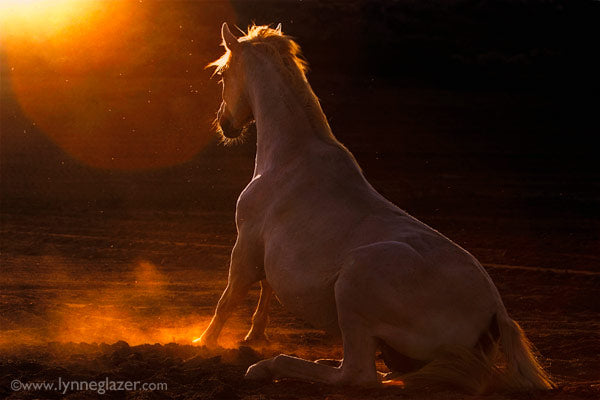Photographer Andy Williams (www.muenchworkshops.com) has been a photographer all of his life. Andy has been teaching professional workshops since 2005, covering some of the major national parks in the West: Yosemite, Bryce Canyon, and Zion. His horse workshops with Lynne Glazer have become favorites of photographers of all levels. His work can be seen on Moon River Photography. Long fascinated with the form and spirit of the horse, in 2003 Lynne Glazer began shooting professionally. Lynne’s images are anything but cookie-cutter - she particularly relishes exploring creative use of light and shadow, striving to capture motion and stillness in the same moment. Her specialty is horses in motion, whether at liberty, in sport or portraits on the move. Pictureline was happy to have Lynne share some tips and photos with readers for approaching a good horse photograph and highlight the workshop Lynne and Andy will be teaching.
USE A LONGER LENS
Lynne: "Everyone has seen photos of horses in the newspaper, taken by hard-working local staffers who shoot every subject under the sun. Overwhelmingly, I've noticed that the equine noses always appear incredibly long, the eyes look tiny, and if the body is in the shot, it's elongated, too. If the shot is of an accomplished athlete, it seems a wonder how they managed it on those spindly legs.
"The key to great horse photos--when they are the main subject--is to grab one of the longest lenses in your kit! The 70-200 mm is the "gold standard," but even your 85 mm will do at the low end. If the horses are part of a landscape where they are in the distance, this wide angle distortion won't happen. The image below was at extreme zoom and was left uncropped ... other than a little extra to the right. Don't be afraid to fill the frame.
GET DOWN!
"In general, equine images are more appealing when the sense of scale is correct, so depending on your horse subject, that may mean getting down on your knees. Consider the scene at your child's birthday party where to his astonishment and delight, you have brought in a pony ride vendor. Imagine the difference between the shots taken from your adult height compared to one where the shot can be experienced from the child's scale. In the admittedly extreme example below, a shot at adult height would have missed the expression on this child's face. If you're shooting the Budweiser Clydesdales or knights aboard their destriers, stay on your feet.
EXPLORE RIM LIGHT
"Horses have whiskers, manes and tails which can catch even the tiniest bit of light--the result can be some absolutely enchanting outlines. With motion, the jackpot can be the dust they raise, but of course, keep an eye on the shutter speed. This horse was rising after a good sand roll, and she paused for a moment, as pesky gnats flew around her."
Learn more in the Muench Workshop on horse photography. Also, visit their website to check out the great workshops all over the world from Africa to Shenandoah, from Death Valley to Big Sur.
RELATED ARTICLES
Far Away Photography - Marrakesh, Morocco
How I Got That Shot - Thomas Stoeckli
How I Got That Shot - Tom Bol and the Glowing Kayak





